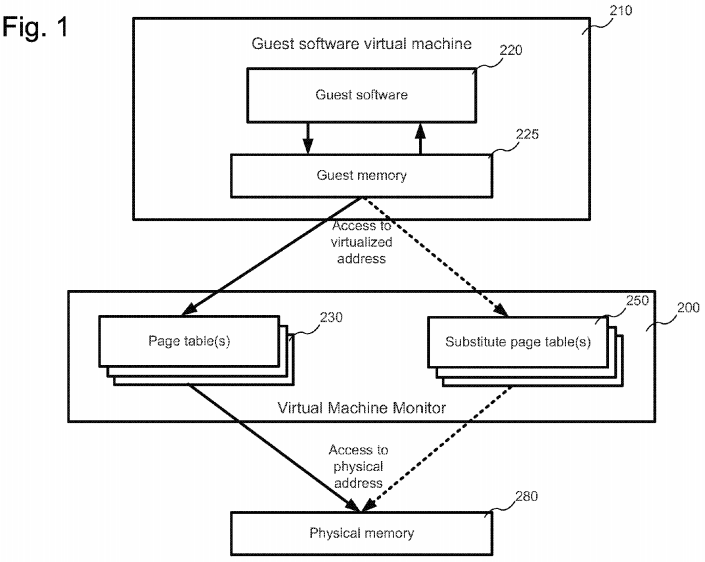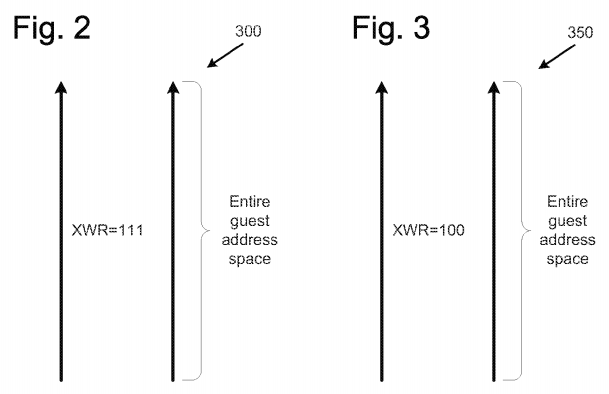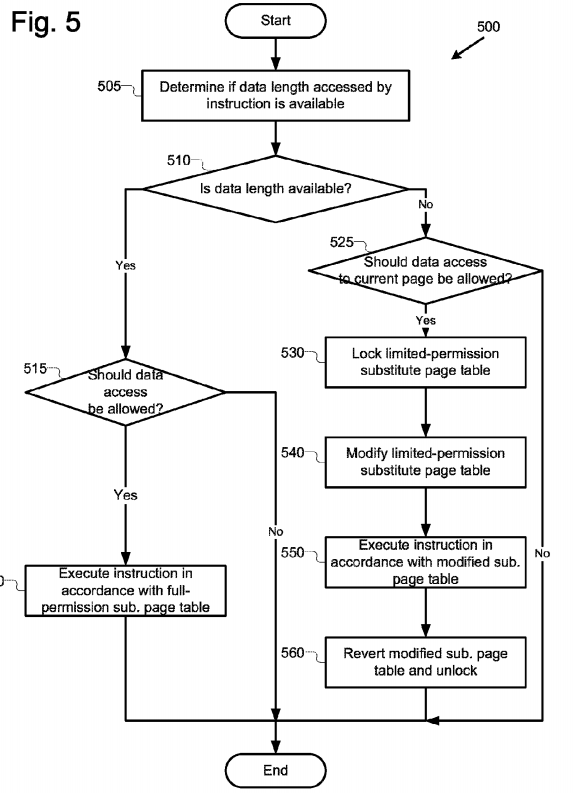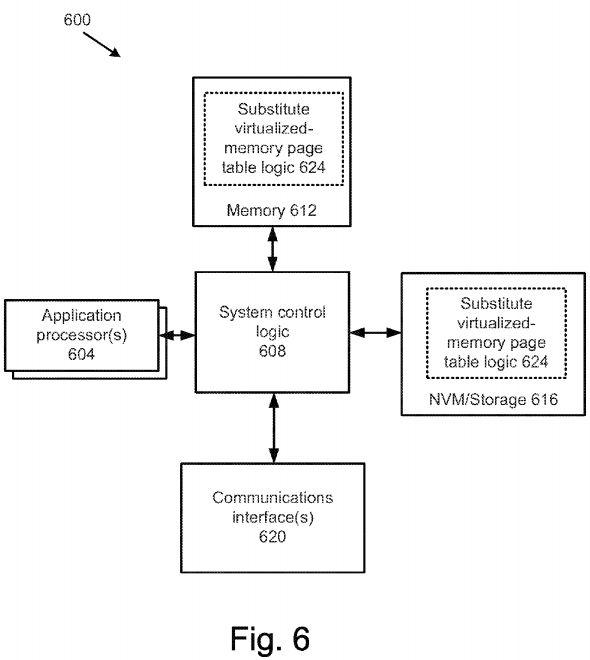BACKGROUND
Many computer systems utilize virtualized memory for security, stability and/or other purposes. In various virtualized-memory systems, a virtual machine monitor ("VMM") may control direct use of memory and/or computer processors in a computer system. The virtual machine monitor, which may be implemented in software and/or hardware, may allow guest software to run only in virtual machines, each containing their own guest address space defined by virtualized memory addresses.
In various systems, these virtualized memory addresses are mapped to physical memory addresses through the use of page tables controlled by the virtual machine monitor. In some systems, these page tables may specify access permissions for memory pages (hereinafter, may simply referred to as "page"). Thus, a page table may define, for each page of virtualized memory presented to a piece of guest software, whether the guest software may 1) execute instructions from that locations in that page, 2) read from locations in that page, and/or 3) write to locations in that page. In various systems, multiple page tables may be used, or switched to during execution, in order to allow particular accesses, as determined by the VMM.
As an example, pages W and X may hold trusted data, while pages Y and Z may hold trusted code sections. To enable code in pages Y and Z to access data in pages W and X, but prevent code in other pages from accessing data in pages W and X, a page table may provide execute permission for pages Y and Z, and read/write permission for pages W and X.
However, in some scenarios, current page table utilization may introduce problems. For example, in a scenario where code in page Y of the above example were supposed to be allowed to access both pages W and X but code in page Z were only allowed to access page W, then the above described page table would be insufficient to provide proper security, and other page tables would be required. Thus, in some systems, many different page tables must be maintained in order to provide different sets of access permissions for different guest software, increasing resource usage and complexity.
Secondly, in some scenarios, no page table may be sufficient to properly control memory location access permissions, as permissions need to be given at a granularity lower than that of a page. For example, a page Q may hold both trusted data D1 and untrusted data D2. To enable untrusted code to access untrusted data D2, a page table would have to have read/write permission for page Q and execute permission for untrusted code at the same time. This would allow untrusted code to access data D2 so that it can access trusted data D1.
Some systems address these issues by keeping a smaller number of page tables and by modifying them on a per-access basis before use. Thus, for example, if access to an address is needed that is not permitted by a currently-used page table, the VMM (after determination that the access is proper) may modify the current page table to temporarily provide the requested read/write permission. Control may then be transferred back to the guest software for data access execution. After execution of the data access, the control may be transferred back to VMM to restore the original permission.
This process may introduce its own inefficiencies, however. In some systems, more than one computer processor may utilize a given page table. Thus, when a page table needs to be modified temporarily for a data access by one processor, any other processor using the modified page table must be paused or otherwise made to wait so that it does not run using the modified permissions. This processor pausing may slow down performance. Additionally, the page table modification time itself incurs a performance penalty and can be a system stability issue.
DETAILED DESCRIPTION OF ILLUSTRATIVE EMBODIMENTS
Methods, apparatuses, and storage media associated with substitutive virtualized-memory page tables are disclosed herein.
In various embodiments, one or more computer-readable storage media may comprise first instructions that, in response to execution by a computing device, cause the computing device to perform one or more operations. The instructions may cause the computing device to determine that a second instruction to be executed on a computer processor of the computing device attempts to perform an access to a virtualized memory address location, the access to the virtualized memory address location being not permitted in accordance with a current virtualized-memory page table. The instructions may also cause the computing device to execute the second instruction on the computer processor in accordance with a substitute virtualized-memory page table, the substitute virtualized-memory page table configured to permit the access to the virtualized memory address location.
Referring to FIG. 1, a block diagram is shown illustrating a virtual machine monitor 200 which may, in various embodiments, provide one or more substitute virtualized-memory page tables 250 ("SPTs") for use to provide temporary access permissions to a guest software virtual machine 210. In various embodiments, the virtual machine monitor 200 and guest software virtual machine 210 may be operated on a computing device, such as a laptop, desktop, server, and/or mobile device. In various embodiments, the SPTs 250 may be provided by the virtual machine monitor 200 to the guest software virtual machine 210 instead of one or more other virtualized-memory page tables 230 ("PTs").

In various embodiments, the guest software virtual machine 210 may include guest memory 225. In various embodiments, the guest memory 225 may include an abstraction of actual physical memory (such as, for example, physical memory 280), that is translated to the physical memory 280 using the virtual machine monitor 200, along with its PTs 230. Thus, as the guest software 220 attempts to access memory location corresponding to a virtual address in the guest memory 225, the guest memory 225 will, in turn refer to the PTs 230 to translate the virtual access to a corresponding physical memory address. In various embodiments, results of the access may be returned after such an access, such as, for example, read results or write acknowledgments. In other embodiments, access error messages may be returned, such as when a memory access is not permitted. These are not illustrated for the purposes of simplified illustration. In various embodiments, that virtual machine monitor providing the PTs 230 and substitute virtualized-memory page tables 250 may be implemented, in whole or in part in hardware. In some embodiments, the guest memory 225 may also comprise guest virtualized memory (not illustrated), with guest virtualized memory addresses being translated into addresses in guest memory 225 by one or more guest virtualized machine page tables (not illustrated). In various embodiments, substitute page tables 250 may be used by the virtual machine monitor regardless of usage or implementation of guest virtualized memory page tables.
In various embodiments, the SPTs 250 may be provided on a temporary basis (indicated by the dotted lines) in order to provide for a temporary change in memory access permissions for memory accesses performed by the guest software virtual machine 210. Thus, in various embodiments, as a memory access is attempted by the guest software virtual machine, that access may not be permitted by a currently-used virtualized-memory page table. However, the virtual machine monitor 200 may determine that the access should be allowed. In various embodiments, rather than modifying the current virtualized-memory page table, as described above, the virtual machine monitor 200 may provide an SPT 250 for use by the guest software virtual machine 210 in place of the current PT.
In various embodiments, the SPT may be configured to allow for the access that was not permitted by the current PT. In various embodiments, the SPT may be so configured by being configured, before the requested access, to provide permission for the requested access.
FIG. 2 shows an example of an SPT, in accordance with various embodiments. As illustrated in FIG. 2, an SPT may be configured, in various embodiments, to permit all types of access for every virtualized memory address in the entire guest software virtual machine address space. (This is illustrated in the example of FIG. 2 as "XWR=111", meaning execute, write, and read access are each respectively permitted.) Thus, in some embodiments, if the virtual machine monitor 200 determines that a guest software virtual machine 210 should be permitted to access a given virtualized memory address that is not allowed by a currently-used PT, the VMM may use the example SPT instead to quickly provide for access to the virtualized memory Address. In various embodiments, because the SPT allows access permissions for the entire guest address space, there may be no need for any further modifications or determinations. The VMM may switch to use of the SPT, allow the memory access, and switch back to the previously-used PT after the access has been performed.

In various embodiments, because the SPT 300 is pre-configured (before access) to allow access to every virtualized memory address location in the guest address space, the SPT 300 may not need to be modified for use by any one computer processor. Thus, in various embodiments, multiple computer processors may utilize the SPT 300 at different points in their respective execution without concern that one computer processor may have to wait on execution to allow for modification by the VMM on behalf of another computer processor.
In various embodiments, however, the SPT 300, which includes full permissions for every virtualized memory address location, may not always be desirable for selection by the VMM 200. In some embodiments, the desirability of using an SPT with full permissions may be determined, at least in part, on the ability of the VMM to determine a length of data access (such as a total number of data bytes) to be performed by an instruction. Thus, when the VMM can determine a length of data access of an instruction, the VMM can determine, for the entire length of data being accessed by the instruction, whether the access should be allowed. If the VMM determines that access is permissible for this entire length, then the VMM may safely use an SPT such as substitute virtualized-memory page table 300 that has full permissions.
However, if such a data length cannot be determined by the VMM, the VMM may not be able to confirm that the requested access be allowed. In such a scenario, in various embodiments the VMM may select an SPT that has less than full permissions for the virtualized memory address for which access has been requested. For example, the VMM may select SPT 350 of FIG. 3 (XWR=100), which has only execute permission for the entire guest virtual machine address space, but does not have read or write permission. In other embodiments, the VMM may select an SPT that has execute and read, but not write, permission for the guest virtual machine address space. For example, such an SPT may be selected when the VMM is protecting memory from writes by untrusted code, but not necessarily from reads. In various embodiments, the VMM may then modify the selected SPT to allow a particular access for the requested virtualized memory address and/or for the page that the virtualized memory address fails into.
In some embodiments, this modification may require additional time and/or resources, and thus may not provide the same efficiency as use of the SPT 300. However, efficiencies over other systems may still be realized as using and modifying the SPT can still be performed without pausing computer processors that are using PTs. In some embodiments, if more than one computer processor is using an SPT that is being modified, these computer processors may be made to wait on execution until the modification is complete. However, if SPTs are provided by the VMM that are unique to (or otherwise associated with) each computer processor, this may obviate the need to cause computer processors to wait during modification. Particular examples of selecting and modifying SPTs are described below. It may also be noted that, while the example SPTs 300 and 350 are each configured with the same permissions for the entire guest software virtual machine address space, in some embodiments, the SPTs may be configured to have the same permissions for less than the entire guest software virtual machine address space.
FIG. 4 illustrates an example substitute virtualized-memory page table utilization process 400 in accordance with various embodiments. In various embodiments, the process may be performed by the VMM 200 and guest software virtual machine 210. The process may begin at operation 420. At operation 420, VMM 200 may generate one or more PT and SPTs. In various embodiments, operation 420 may include generating SPTs that have full permissions for an entire guest software virtual machine address space, such as, for example, SPT 300. In various embodiments, operation 420may include generating SPTs that have fewer than full permissions for one or more parts of an entire guest software virtual machine address space, such as, for example, SPT 350. In various embodiments, operation 420 may include generating SPTs that that are associated with particular computer processors; in some embodiments, operation 420 may generate multiple similar SPTs such that there is one associated with each computer processor.

Next, at operation 430, the guest software virtual machine 210 may begin execution of guest software 220. This execution may include the guest software virtual machine 210 operating under control of the VMM 200 and utilizing one or more PTs 230. At operation 440, the VMM may identity that an instruction to be executed by the guest software virtual machine 210 will attempt a memory access that is not permitted by a currently-used PT 230. Next, at operation 450, the VMM 200 and guest software virtual machine 210 may execute the instruction in accordance with an SPT250. Particular embodiments of this operation are described below. In various embodiments, the instruction may be executed under a flag or other hardware- or software-enabled construct that allows only the single instruction itself to be executed before control is returned to the previously-used PT. This may help confirm that only the identified instruction is executed in accordance with the increased permissions of the STP.
After conclusion of operation 450, at operation 460, the guest software virtual machine 210 may continue execution of guest software 220 using the previously-used PT 230. The process may then proceed back to operation 440 if another instruction is identified which is not permitted by the currently-used PT 230. After the guest software virtual machine 210 has completed execution of guest software 210, the process may end (not illustrated).
FIG. 5 illustrates an example an example instruction execution process 500 utilizing SPTs in accordance with various embodiments. In various embodiments, the process may be performed by the VMM 200 and guest software virtual machine 210. In various embodiments, process 500 may describe one or more implementations of operation 450 of process 400. In various embodiments, process 500 may be performed with references to an instruction which attempts a virtualized memory access that is not permitted by the current PT, such as by the result of operation 440 of process 400.

The process may begin at operation 505. At operation 505, the VMM may determine if a data length (such as a total number of data bytes) to be accessed by the instruction is available. Next, at operation 510, the VMM may perform one of two sets of operations based on whether the data length was available at operation 505. If the data length was determined to be available, then at operation 515, the VMM 200 may determine whether the instruction should be allowed to perform its requested access. If the VMM determines that the instruction should not be allowed to perform its requested access, then process may end and an optional error message (not illustrated) may be returned. If the VMM determines, at operation 515, that the access should be permitted, then at operation 520, the VMM may execute the instruction in accordance with an STP that has full permissions, such as example STP 300. In various embodiments, the instruction may be executed under a flag or other hardware- or software-enabled construct that allows only the single instruction itself to be executed before control is returned to the previously-used PT. This helps confirm that only the instruction at hand is executed in accordance with the STP, and that standard PT access permissions are used for subsequent instructions executed by the guest software virtual machine 210. The process may then end.
If however, the VMM has determined that the access data length for the instruction is not available, then the VMM may perform a series of operations to utilize an STP with fewer than all permissions. Thus, at operation 525, the VMM 200 may determine whether the instruction should be allowed to perform its requested access on a current page (e.g., a current page for which it was determine that the instruction was not permitted access). If the VMM determines that the instruction should not be allowed to perform its requested access on that page, then process may end and an optional error message (not illustrated) may be returned. If the VMM determines, at operation 525, that the access should be permitted to the current page, then at operation 530, the VMM may obtain a lock on an STP with a limited set of permissions, such as, for example, STP 350. In various embodiments, the VMM may obtain a lock on the STP in order that it may modify the STP without causing conflict with other processes that may also wish to use and/or modify the STP. In some embodiments, if the STP is particular to the processor executing the instruction, then the lock operation 530 may not be performed.
Next, at operation 540, the VMM may modify the STP to allow the requested access. In various embodiments, this modification may include modifying the STP only for the initial page the instruction seeks to access (since the data length is unknown). Next, at operation 550, the VMM may execute the instruction in accordance with the modified STP. Again, in various embodiments, the instruction may be executed under a flag or other hardware- or software-enabled construct that allows only the single instruction itself to be executed before control is returned to the previously-used PT. Then, at operation 560, the VMM may modify the STP to revert it back to its previous state. The VMM may also unlock the STP at this operation. The process may then end.
The techniques and apparatuses described herein may be implemented into a system using suitable hardware, firmware, and/or software to configure as desired. FIG. 6 illustrates, for one embodiment, an example system 600 including at least processors 604, each having one or more processor cores, system control logic 608 coupled to at least one of the processors 604, memory 612 coupled to system control logic 608, non-volatile memory ("NVM")/storage 616 coupled to system control logic 608, and one or more communications interface(s) 620 coupled to system control logic608. In various embodiments, the system 600 may include components of a CPU-based software system, a management engine system, or a combination of the two.

System control logic 608 for one embodiment may include any suitable interface controllers to provide for any suitable interface to at least one of the processors 604 and/or to any suitable device or component in communication with system control logic 608. The processors may include a dedicated application processor upon which an application environment may be operated, as well as a separate service processor upon which a manageability engine may be operated. The system may include additional processors or processing cores (not illustrated).